452 Search Results for visual supports
May 21, 2015
by Carole Zangari -
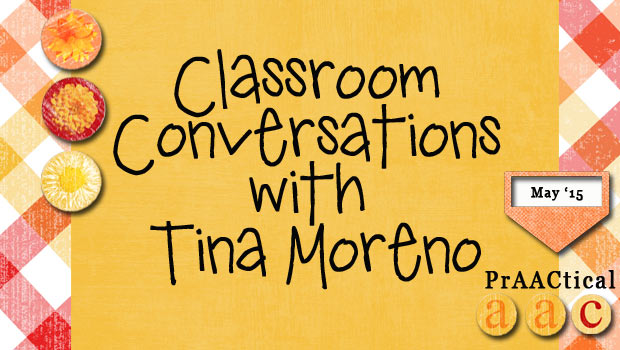
Better Hearing and Speech Month continues with guest blogger Tina Moreno. In this post, Tina shares some thoughts on building meaningful conversations in the classroom. She also made her visual support materials available for downloading (link at the end of her post). You can read Tina’s previous post for BHSM here. CONVERSATIONS IN THE CLASSROOM Fostering opportunities for meaningful conversation is critical throughout the school setting. Great discussions can happen in the classroom, but it can prove challenging for students to remain on topic, take conversational turns and give their peers wait time. In order to help students acquire these skills, we need to provide direct instruction, modeling by adults (and typically developing peers whenever possible!) and visual supports. Aim for the conversation target It can be difficult for students to keep track of the conversation target, especially in large group, fast-paced settings. It can be especially challenging for... [Read More...]
April 21, 2015
by Carole Zangari -
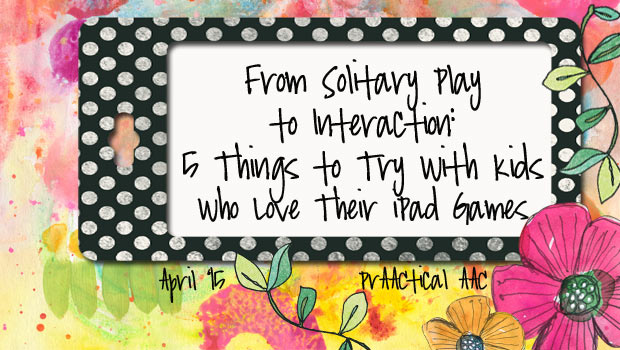
“But my kid wants to use the app on his own terms, not with ME!” Ever faced this conundrum? There are so many wonderful apps that are terrific for building interaction and language skills, but some of our prAACtical friends don’t want us to interact with them during iPad play**. Today, we’re thinking about strategies to use when kids would rather engage in solitary play as opposed to welcoming us as interaction partners in their iPad games. How can we help them increase their tolerance for interaction when playing on the iPad? Here are a few things to try. Make expectations clear with visual supports. It’s hard to cooperate when you don’t have an understanding of what’s supposed to happen. When kids are used to playing games, reading books, or watching videos on their own, they sometimes resist our participation out of the fear that they won’t get to do... [Read More...]
April 13, 2015
by Carole Zangari -

Core Words for the Month (2013 List): big, busy, do, drink, feel, he, in, make, out, some, tell, who By definition, core words are useful in any situation, with any topic and any communication partner. They are the perfect words for Earth Day because they are words that they we re-use and recycle. Even though it is a very minor holiday (at least in the US), most schools do a lot of thematic work around the topic, both because it ties in so beautifully with science education, but also because all kids seem to have a connection with and curiosity about the natural world. Before we knew better, SLPs would spend lots of time programming specific vocabulary into the learner’s AAC device. (I’m guilty as charged and can still remember trying to find symbols for things like trash compactor and pollution.) For learners who have good command of core vocabulary, we... [Read More...]
April 2, 2015
by Carole Zangari -
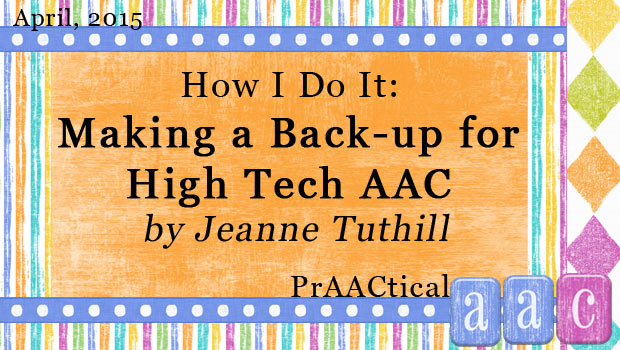
If you’ve ever woken up in the middle of the night sweating over one of your AAC clients who doesn’t have a back-up communication tool, then this post is for you. Jeanne Tuthill is back with another prAACtical suggestion, this time on the importance of ensuring that people with AAC needs have communication options when their technology isn’t available or appropriate. In keeping with the generous spirit of the AAC field, Jeanne also shares her files for this project. Enjoy! How I Do It: Making a Back-up for High Tech AAC Each time I teach my graduate class I try to invite at least one AAC user in as a guest speaker to share their story with the students in the class. It never ceases to fill my students with awe and appreciation for the challenges that AAC users face on a daily basis. My students often list it as... [Read More...]
March 29, 2015
by Carole Zangari -
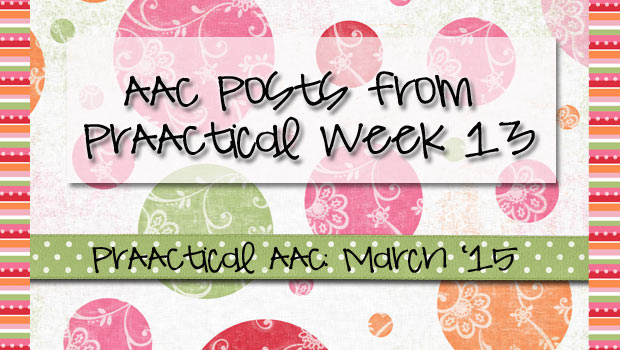
Monday: 5 Ways to Use Anchor Charts & Other Visual Supports in AAC Language Therapy Tuesday: PrAACtical Resources: Chronic Pain Assessment in Children with Disabilities Wednesday: Video of the Week – Lily Gets New Words! Thursday: Magic Moments with Toca Train by Nerissa Hall and Hillary Jellison
July 10, 2014
by Carole Zangari -
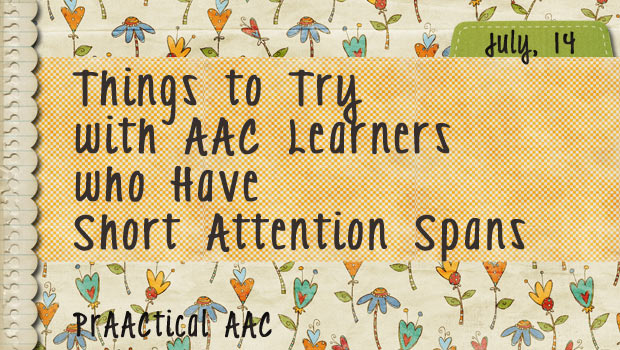
We love talking to AAC practitioners, hearing their stories, and picking up some tips along the way. Some conversations we love for the creative ideas or underlying passion. Others are memorable for less positive reasons. But still, they give us pause and challenge us to be better problem-solvers. “I love those ideas, but they won’t work with MY client: He doesn’t pay attention. He’s just not ready for all this. How do you expect me to teach someone with such a short attention span?” Glad you asked! First, don’t blame the learner. Like having short legs or frizzy hair, attention span is something over which some learners have little or no control. Their physiology is their physiology and they may not like it any more than we do. Use high-interest components in your therapy. The goals are the goals, but we can use things the client likes to make working on... [Read More...]
June 30, 2014
by Carole Zangari -
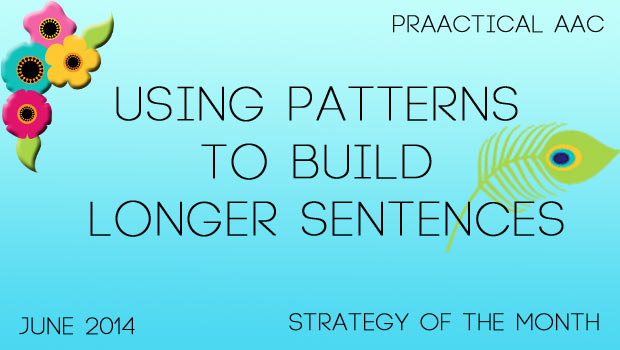
Throughout the month, we’ve been talking about building sentence length and complexity. We’ll end the month with a concept that applies to both beginning communicators and those with more complex language skills. Human beings are pattern-seekers. We notice similarities and distinctions, and compare things that are new to us to things we already know about. As we go through our lives, we draw on our pattern-seeking skills to learn about and understand the world. How can we use this intrinsic trait to help us in teaching language to AAC learners? Consider patterns when choosing your targets: Increasing sentence length is a broad goal that gives us lots of flexibility in how we design our intervention. We can lengthen sentences by adding descriptors, temporal terms, conjunctions, embedded clauses, and more. Within each category, there are many options. For a beginning communicator, we might teach descriptors related to appearance (e.g., size, color,... [Read More...]
June 23, 2014
by Robin Parker -
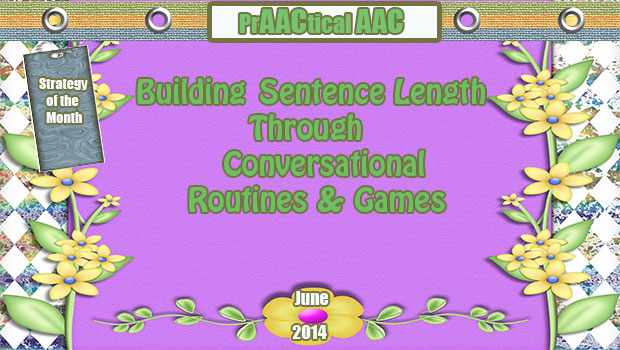
Building sentence length beyond the simple sentence level can be a lot of fun for those of us who love language. Additionally, and even more important, expanded sentences can provide communication impact and power to the communicator. Expanded sentences usually means moving from the simple to complex sentence. As Carole mentioned last week, we often begin with conjunctions like ‘because’, ‘but’, ‘so’, ‘if’, before’, after’. Here are some ideas for conversational routines and games that allow for frequent repetition with variety as well as strong communication power that will help with making it worthwhile to use longer sentences. “Pretty Please” Routine- This routine involves using ‘because’ to negotiate with longer sentences. This routine is reserved for requests that are possible but not always honored. In the case of teaching, we start with requests that can be honored if “pretty please because I worked hard or some other reasonable reason is... [Read More...]
June 6, 2014
by Robin Parker -
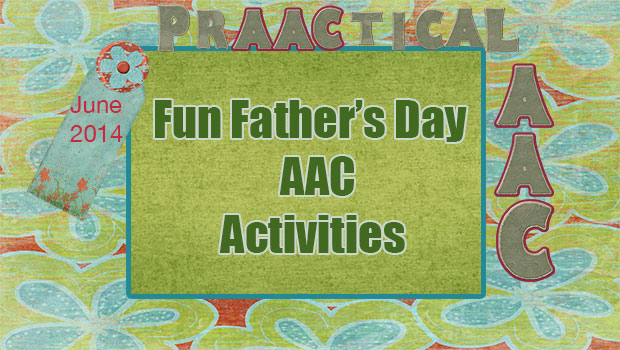
It’s prAACtically Father’s Day. There are many things to talk about, create, eat, and prepare for this special day. Check out these fun activities that can be done during communication therapy, at home, or at school. Some can be done with dad and others can be done for dad as gifts. Enjoy the communication process. Record “I Love You” on a one hit message device/card/picture. You can give a card or talking picture as a gift. You can use the one hit message device to tell dad “I love you” many times for father’s day and beyond. Use Talking to Dad Visual Supports/Worksheets by Joel Shaul at Autism Teaching Strategies to create meaningful conversations Play a memory game with dad that is supported with PCS (Thank you Mayer Johnson) Use a visual recipe to prepare a sweet treat for dad. Consider chocolate covered pretzels. Create a power point book about... [Read More...]
May 30, 2014
by Robin Parker -
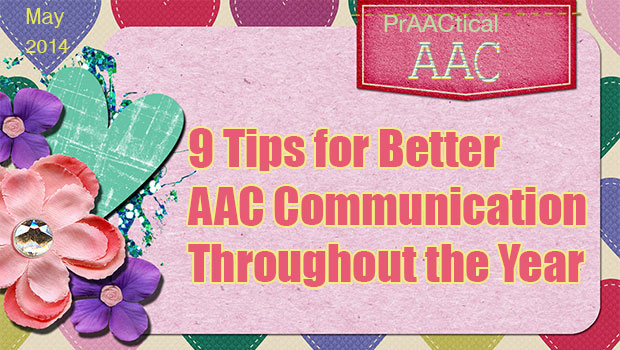
Although Better Hearing and Speech Month is ending, we want to continue best prAACtices in all teaching interactions throughout the year. Here are 9 AAC facilitator tips to help with this goal. Provide Aided Language Input (ALI)– ALI is modeling AAC style. Speak AAC to the AAC user. Use Scaffolding– Scaffolding is a verbal and visual strategy that has the facilitator build upon prior knowledge of the learner in order for the learner to integrate a new concept or skill. Model words and concepts to add information onto what the AAC user already knows and uses. Provide Expansions and Extensions– A form of modeling. Add a word to the spontaneous communication from the learner. The facilitator models a conceptual or grammatical word in the form of a model. Use Recasting– Recasts serve to add or correct information without obstructing the natural flow of communication. Recasting is another form of modelling. The... [Read More...]









